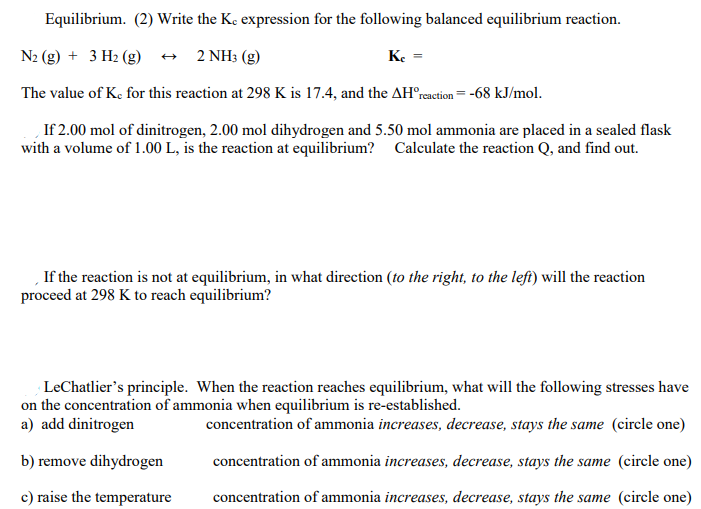Equilibrium. (2) Write the Ke expression for the following balanced equilibrium reaction. N2 (g) + 3 H2 (g) 2 NH3 (g) Ke = The value of Kç for this reaction at 298 K is 17.4, and the AH°reaction= -68 kJ/mol. If 2.00 mol of dinitrogen, 2.00 mol dihydrogen and 5.50 mol ammonia are placed in a sealed flask with a volume of 1.00 L, is the reaction at equilibrium? Calculate the reaction Q, and find out. , If the reaction is not at equilibrium, in what direction (to the right, to the lefi) will the reaction proceed at 298 K to reach equilibrium? LeChatlier's principle. When the reaction reaches equilibrium, what will the following stresses have on the concentration of ammonia when equilibrium is re-established. a) add dinitrogen concentration of ammonia increases, decrease, stays the same (circle one) b) remove dihydrogen concentration of ammonia increases, decrease, stays the same (circle one) c) raise the temperature concentration of ammonia increases, decrease, stays the same (circle one)
Equilibrium. (2) Write the Ke expression for the following balanced equilibrium reaction. N2 (g) + 3 H2 (g) 2 NH3 (g) Ke = The value of Kç for this reaction at 298 K is 17.4, and the AH°reaction= -68 kJ/mol. If 2.00 mol of dinitrogen, 2.00 mol dihydrogen and 5.50 mol ammonia are placed in a sealed flask with a volume of 1.00 L, is the reaction at equilibrium? Calculate the reaction Q, and find out. , If the reaction is not at equilibrium, in what direction (to the right, to the lefi) will the reaction proceed at 298 K to reach equilibrium? LeChatlier's principle. When the reaction reaches equilibrium, what will the following stresses have on the concentration of ammonia when equilibrium is re-established. a) add dinitrogen concentration of ammonia increases, decrease, stays the same (circle one) b) remove dihydrogen concentration of ammonia increases, decrease, stays the same (circle one) c) raise the temperature concentration of ammonia increases, decrease, stays the same (circle one)
Chemistry: The Molecular Science
5th Edition
ISBN:9781285199047
Author:John W. Moore, Conrad L. Stanitski
Publisher:John W. Moore, Conrad L. Stanitski
Chapter12: Chemical Equilibrium
Section: Chapter Questions
Problem 121QRT: When a mixture of hydrogen and bromine is maintained at normal atmospheric pressure and heated above...
Related questions
Question
11-please see attached

Transcribed Image Text:Equilibrium. (2) Write the Ke expression for the following balanced equilibrium reaction.
N2 (g) + 3 H2 (g)
2 NH3 (g)
Ke =
The value of Kç for this reaction at 298 K is 17.4, and the AH°reaction= -68 kJ/mol.
If 2.00 mol of dinitrogen, 2.00 mol dihydrogen and 5.50 mol ammonia are placed in a sealed flask
with a volume of 1.00 L, is the reaction at equilibrium? Calculate the reaction Q, and find out.
, If the reaction is not at equilibrium, in what direction (to the right, to the lefi) will the reaction
proceed at 298 K to reach equilibrium?
LeChatlier's principle. When the reaction reaches equilibrium, what will the following stresses have
on the concentration of ammonia when equilibrium is re-established.
a) add dinitrogen
concentration of ammonia increases, decrease, stays the same (circle one)
b) remove dihydrogen
concentration of ammonia increases, decrease, stays the same (circle one)
c) raise the temperature
concentration of ammonia increases, decrease, stays the same (circle one)
Expert Solution
This question has been solved!
Explore an expertly crafted, step-by-step solution for a thorough understanding of key concepts.
This is a popular solution!
Trending now
This is a popular solution!
Step by step
Solved in 4 steps with 3 images

Knowledge Booster
Learn more about
Need a deep-dive on the concept behind this application? Look no further. Learn more about this topic, chemistry and related others by exploring similar questions and additional content below.Recommended textbooks for you

Chemistry: The Molecular Science
Chemistry
ISBN:
9781285199047
Author:
John W. Moore, Conrad L. Stanitski
Publisher:
Cengage Learning


Chemistry
Chemistry
ISBN:
9781305957404
Author:
Steven S. Zumdahl, Susan A. Zumdahl, Donald J. DeCoste
Publisher:
Cengage Learning

Chemistry: The Molecular Science
Chemistry
ISBN:
9781285199047
Author:
John W. Moore, Conrad L. Stanitski
Publisher:
Cengage Learning


Chemistry
Chemistry
ISBN:
9781305957404
Author:
Steven S. Zumdahl, Susan A. Zumdahl, Donald J. DeCoste
Publisher:
Cengage Learning

Chemistry: An Atoms First Approach
Chemistry
ISBN:
9781305079243
Author:
Steven S. Zumdahl, Susan A. Zumdahl
Publisher:
Cengage Learning

Chemistry & Chemical Reactivity
Chemistry
ISBN:
9781337399074
Author:
John C. Kotz, Paul M. Treichel, John Townsend, David Treichel
Publisher:
Cengage Learning

Chemistry & Chemical Reactivity
Chemistry
ISBN:
9781133949640
Author:
John C. Kotz, Paul M. Treichel, John Townsend, David Treichel
Publisher:
Cengage Learning